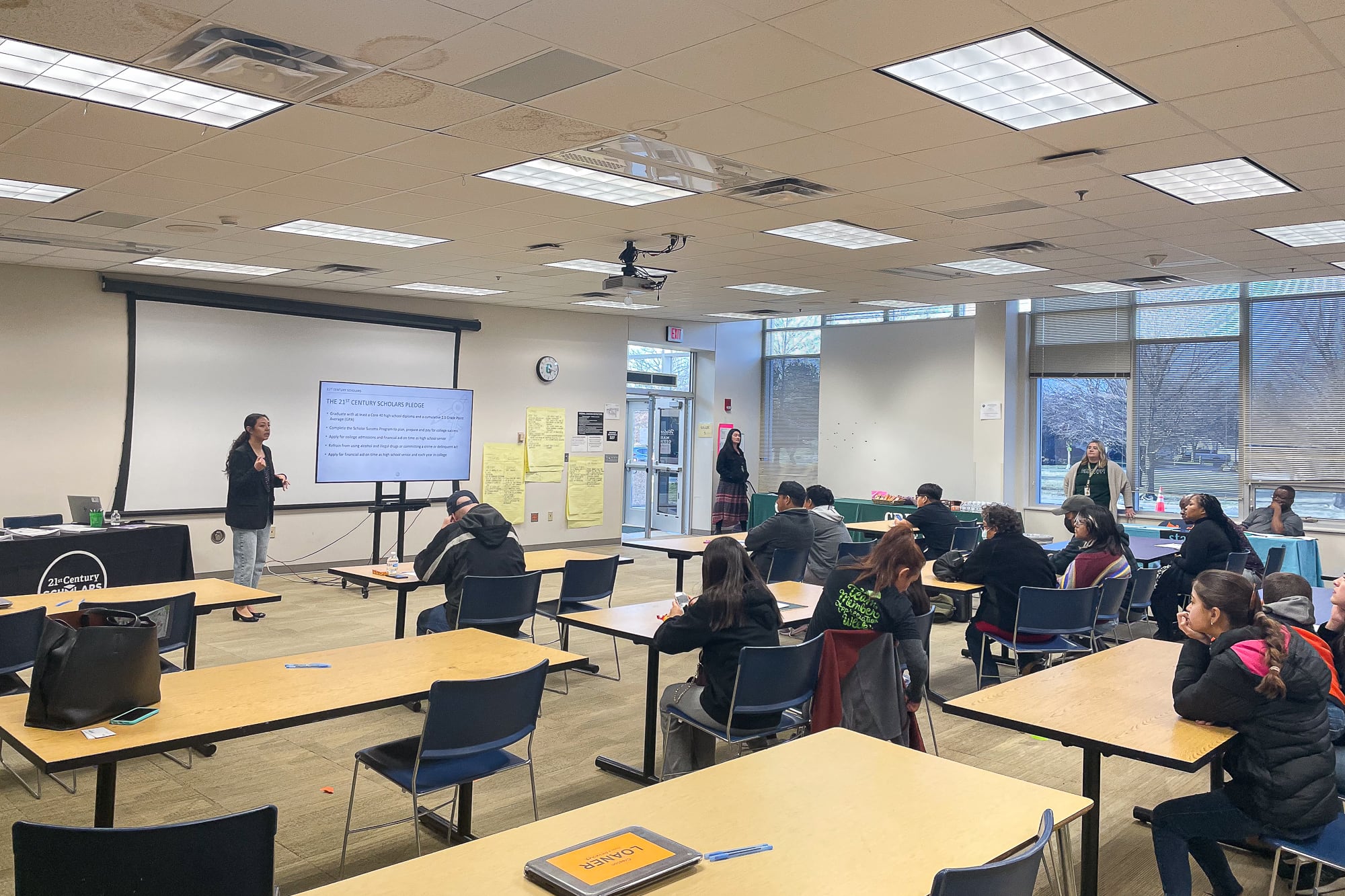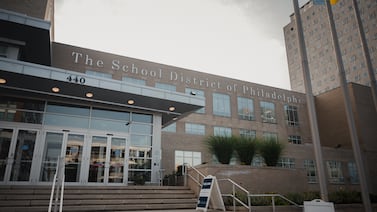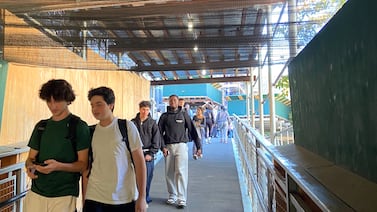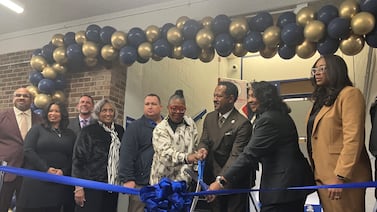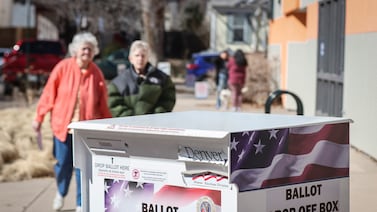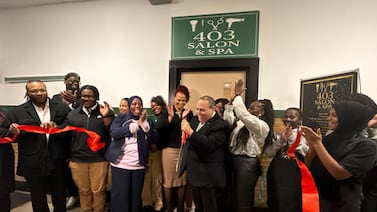Sign up for Chalkbeat Indiana’s free daily newsletter to keep up with Indianapolis Public Schools, Marion County’s township districts, and statewide education news.
Before she became a career coach at Vincennes University or graduated from the University of Southern Indiana, Raychel Geiser got crucial help from a state program that’s over three decades old: 21st Century Scholars.
Indiana’s 21st Century Scholars program allows students who meet eligibility requirements to receive a two- or four-year scholarship that pays up to 100% tuition at a public Indiana college or university and partial tuition at private colleges.
Geiser, 28, whose family struggled with finances and substance abuse, said that not only has she benefited from the program, but so have her six siblings. All of their lives, she said, “have been changed drastically because of that opportunity.”
“I wouldn’t have been able to go to college” without the scholarship, Geiser said. “That’s how I got my degree and then landed my current job.”
Since it began in 1990, the 21st Century Scholars program has helped more than 50,000 Hoosiers earn a college degree, according to the Indiana Commission for Higher Education.
Recent changes to the program have allowed it to dramatically increase the number of students it serves in high school. At the same time, there are significant challenges for the program and those who oversee it.
The state’s college-going rate is dropping after several years of being stagnant. Policymakers are placing more emphasis and career and technical education, which might lead more students away from traditional higher education. And high school attendance can affect coordinators’ ability to keep in touch with students and make sure they’re on track to meet program requirements.
All that means state officials, K-12 educators, and others are keeping a close eye on how the program and institutions of higher education can adapt to the changing environment and students’ needs.
Officials applaud college scholarship program’s results for students
Seventh and eighth graders who are Indiana residents, U.S. citizens, and meet certain income eligibility requirements can start participating in 21st Century Scholars. For a household of four, for example, the maximum annual income is $59,478.
According to the commission, there are currently 150,000 enrolled scholars in high school and 15,000 active scholars in college across Indiana.
Since 2011, students have had to complete 12 steps as part of the Scholar Success Program during high school to earn scholarships. Requirements include participating in an extracurricular or service activity, getting workplace experience, and filing the Free Application for Federal Student Aid.
Students must also meet terms outlined in a Scholar Pledge, such as achieving a cumulative GPA of at least 2.5 in high school and complete at least 30 credit hours each academic year in higher education.
“As long as students hit all of those benchmarks, then they will be eligible for a life-changing amount of financial aid,” said Zachary Cullum, assistant director for K-12 outreach at the commission.
However, one of the most recent and significant changes to 21st Century Scholars was a 2023 law that enabled the commission to automatically enroll all financially eligible students into the program.
Since implementing automatic enrollment, outgoing Indiana Commissioner for Higher Education Chris Lowery said the cohort numbers have doubled.
Lowery touts the college-going rate of 21st Century Scholars as one of the program’s successes. Around 80% of scholars go to college, compared with nearly 52% of all Indiana high school graduates. Lowery also said scholars complete college at a higher rate than their peers from low-income backgrounds.
“The requirements to stay a 21st Century Scholar give that extra motivation,” said Carter Jones, a senior math major at Indiana University.
Vincent Isom, director of the 21st Century Scholars Program at Indiana University, believes that despite the statewide college-going rate dropping from about 60% pre-COVID, the college-bound rate for 21st Century Scholars will remain strong.
“The percentage of 21st Century Scholars going to college now is higher than any other group in the state," Isom said. “On the horizon, it’s a matter of making sure that students are educated so they can make a choice for themselves.”
Jakahi Freeman, a media advertising major at Indiana University, said the experience has inspired him to pay it forward.
“With the skills that I built with this [21st Century Scholars] internship, as well as my schooling program, media advertising, I’m hoping to get into the education field and continue the work that I’m doing,” said Freeman, a senior.
Automatic enrollment in scholarship program ‘a huge blessing’
Automatic enrollment into the 21st Century Scholars Program not only put more students on the college path, but it also relieved the commission from one of its greatest challenges: tracking down and enrolling eligible students.
“[Automatic enrollment has] allowed us to focus our efforts on helping the students who are enrolled in the program with our Scholar Success Program activities that we have and doing financial aid nights,” said Cullum. “It’s been a huge blessing to us.”
However, Cullum said one of the current challenges for regional outreach coordinators is getting scholars to meet in person. Chronic absenteeism rates remain high in grades 9-12, and nearly 1 in 3 Hoosier students was chronically absent during their senior year, according to the 2024-2025 state data.
“Once they get in front of us, it’s easy to guide those students through the process and make sure that they’re eligible,” Cullum said.
Ensuring students meet each deadline in the Scholar Success Program, such as filing the FAFSA, is another struggle.
The commission announced in August that the state reached the 60% FAFSA filing goal set for high school seniors in the class of 2025, including more than 72% of 21st Century Scholars.
Even if students get a job right after high school, it’s still important to ensure “that they’re still meeting all their steps just in case that higher education is going to be an opportunity for them and leaving themselves open to not shutting the door on themselves,” Cullum said.
Lowery believes that the push for work-based learning opportunities in Indiana is another important piece of the education puzzle that can be blended with higher education and the 21st Century Scholar experience.
In July, the Richard M. Fairbanks Foundation awarded nearly $13 million to eight Indiana organizations for apprenticeship programs. And the Indiana Department of Workforce Development secured $6.25 million in federal funding to grow Registered Apprenticeship Programs across the state.
“The reality is that most research firms, think tanks, and others say that by around 2030 to early 2030s, 70 to 80% of our population is going to need something beyond a high school diploma. And all of those things fit in concert. It’s not one or the other,” Lowery said.
Though Lowery’s last day as commissioner is Oct. 10, and Secretary of Education Katie Jenner will be the new commissioner of higher education, Lowery remains excited to see how automatic enrollment into the 21st Century Scholars Program will impact more students, particularly in 2027.
That’s when the first group of students who were automatically enrolled will graduate, so it’s the first year “we have made certain with the automatic enrollment and other shifts that we’ve done everything to make sure we don’t miss students and to make sure that students are getting to do the Scholar Success Program,” Lowery said.
Colleges and universities must also prepare for how automatic enrollment will lead to more students on campuses, Isom said.
He said it’s important that “a program or universities like mine are prepared with the human resources and the financial resources, that universities are conscious of the needs of this population.”
Reach Chalkbeat Indiana at in.tips@chalkbeat.org

